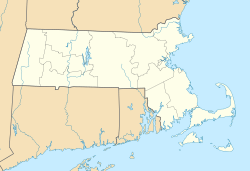Hubbardston Town Common Historic District facts for kids
Quick facts for kids |
|
|
Hubbardston Town Common Historic District
|
|

First Parish Unitarian Church
|
|
| Location | Hubbardston, Massachusetts |
|---|---|
| Area | 1.2 acres (0.49 ha) |
| Built | 1773 |
| Architect | Stowell, Abel; Fales, J.F. |
| Architectural style | Greek Revival |
| NRHP reference No. | 00001396 |
| Added to NRHP | November 22, 2000 |
The Hubbardston Town Common Historic District is a special place in Hubbardston, Massachusetts. It includes the town's main common area, the old First Parish Church from 1773, and the town's first cemetery. This area has been important for the town's community and religious events since the 1760s. It was added to the National Register of Historic Places in 2000. This means it's a historically important site in the United States. The district was even named one of the "1,000 Places to Visit in Massachusetts."
Contents
Exploring Hubbardston's Historic Center
The town of Hubbardston began in the 1760s. It was first part of Rutland. Hubbardston officially became its own town in 1767. The town center was planned in 1773. This is where Main Street (Massachusetts Route 68) and Brigham Street meet today.
The Old Burying Ground
In 1773, the town also set up its first cemetery. This old burying ground is just north of the church. It has stone walls around it. There are about 500 marked graves here. The oldest graves date back to 1777. People continued to be buried here well into the 1800s.
The Town Common Area
The common is west of the church, where the roads meet. It has many memorials. Most of these honor the town's military veterans. You can also find old foundations here. These are from the town's first schoolhouse. There are also remnants of horse sheds. These sheds used to stand near the church.
The First Parish Church
A meeting house was planned in 1773. This building would serve as both a church and a place for town meetings. It was not fully finished until the 1790s. More improvements were made in the early 1800s. This was a time when the town was growing a lot.
In 1842, the church was rebuilt. It was given a new look in the Greek Revival style. However, it still used the original wooden frame from 1773. This building was used for many years. It hosted town meetings and elections even into the 1900s.



